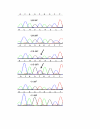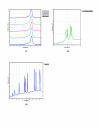Detection of mutations in the dystrophin gene via automated DHPLC screening and direct sequencing
- PMID: 11710958
- PMCID: PMC59832
- DOI: 10.1186/1471-2156-2-17
Detection of mutations in the dystrophin gene via automated DHPLC screening and direct sequencing
Abstract
Background: Currently molecular diagnostic laboratories focus only on the identification of large deletion and duplication mutations (spanning one exon or more) for Duchenne Muscular Dystrophy (DMD) yielding 65% of causative mutations. These mutations are detected by an existing set of multiplexed polymerase chain reaction (PCR) primer pairs. Due to the large size of the dystrophin gene (79 exons), finding point mutations (substitutions, deletions or insertions of one or several nucleotides) has been prohibitively expensive and laborious. The aim of this project was to develop an effective and convenient method of finding all, or most, mutations in the dystrophin gene with only a moderate increase in cost.
Results: Using denaturing high performance liquid chromatography (DHPLC) screening and direct sequencing, 86 PCR amplicons of genomic DNA from the dystrophin gene were screened for mutations in eight patients diagnosed with DMD who had tested negative for large DNA rearragements. Mutations likely to be disease-causative were found in six of the eight patients. All 86 amplicons from the two patients in whom no likely disease-causative mutations were found were completely sequenced and only polymorphisms were found.
Conclusions: We have shown that it is now feasible for clinical laboratories to begin testing for both point mutations and large deletions/duplications in the dystrophin gene. The detection rate will rise from 65% to greater than 92% with only a moderate increase in cost.
Figures




References
-
- Menache C, Darras B. Dystrophinopathies. Neuromuscular Disorders in Clinical Practice. Edited by: Katirji, Kaminski, Preston, Ruff, Shapiro. Publisher: Butterworth Heinemann.
-
- Yoshida M, Ozawa E. Glycoprotein complex anchoring dystrophin to sarcolemma. J Biochem (Tokyo) 1990;108:748–752. - PubMed
-
- Ervasti JM, Campbell KP. Membrane organization of the dystrophin-glycoprotein complex. Cell. 1991;66:1121–1131. - PubMed
-
- Emery AEH. Duchenne Muscular Dystrophy, 2 edn New York: Oxford University Press; 1987.
Publication types
MeSH terms
Substances
Grants and funding
LinkOut - more resources
Full Text Sources
Other Literature Sources

